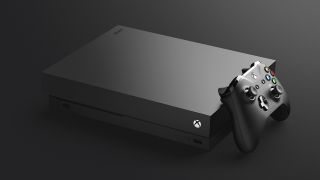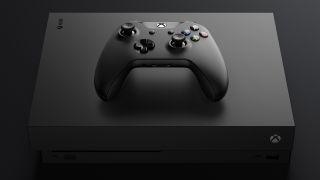With the raw power of Xbox One X, Microsoft has a shot at getting back on top

It might be hard to imagine now, given how the last few years have gone, but once upon a time the Xbox was thought of as the powerhouse console. Though Microsoft didn't always have quite the same robust library PlayStation was able to offer, especially in the era of the original Xbox and the PS2, what it did have was a small but significant technological edge. With the Xbox One X, Microsoft aims to get back to its king-of-the-tech-hill status, and it's a distinction that the brand needs badly right now.
That edge in power was sanded down during the current generation, when there's been rampant talk about how much of the Xbox One's power was diverted to Kinect, how many cross platform games ran and looked better on PS4, how 900p was more common on Xbox One than proper 1080p (the gold standard when these consoles launched). Piled atop all the abuse around how the Xbox One was lagging behind in terms of power were the even worse offenses early on, with consumers being told that the console would need to always be connected to the internet and loose talk about how it wouldn't be able to play used games. Microsoft further crippled their launch by trying to focus attention on the Xbox One as a "media center, family room" console rather than as a platform to play the best new games.
The reaction at this year's E3 is not unlike the kid at the playground who has had enough of all the nitpicking and bullying. Not powerful enough? We'll make the most powerful console ever built, a console that can almost rival contemporary PCs in terms of capability. Too much family-friendly, pan-media focus? We'll make our entire E3 conference about games, packing 42 titles into the Xbox E3 2017 presentation. And head of Xbox Phil Spencer has been vocally evangelizing the new console's power and readiness for our 4K, HDR future - both during the Xbox presser and in interviews throughout the week of E3 2017 - openly talking about how he wants the Xbox brand to be identified with cutting-edge power.
While it's difficult to talk in terms of failure about a console that was the fastest selling Xbox out of the gate, the Xbox One X launch looks like Microsoft's attempt to take a mulligan on the current generation. It's a blatant and savvy attempt to rehabilitate its image, something Phil Spencer has been striving for since he took the reins from the team responsible for the original Xbox One launch. And it's part of a broad strategy to recapture the core gaming audience that Microsoft has realized is the most important (and perhaps only) audience for its consoles.

The Xbox One X was revealed alongside a limited-time reduced price for the slim, less expensive version of the console, the Xbox One S, as well as the announcement of backwards compatibility on all three consoles reaching back to the original Xbox. Spencer and his team have been open about the fact that the Xbox One X isn't for everyone, and the Xbox One S is a better fit for players who aren't obsessed with owning the latest console hardware or are on a budget that doesn't allow for the extravagance of spending $500 on a new gaming console. As much as the Xbox team seems narrowly focused on recapturing the core gamers some of its Xbox One messaging might have alienated, they do seem committed to making sure their lineup appeals to all gamers, regardless of their investment in the hobby (or their discretionary income). It's a message they pushed hard during their E3 presentation, repeatedly referring to their lineup of games as the "most diverse ever."
The push to reclaim bragging rights as the platform with the power also feeds into Microsoft's move to make many (if not all) of its first party exclusives playable on both Windows 10 and Xbox One. Building an ecosystem that also includes PC gamers, with their notorious passion for peak performance and cutting edge hardware, enhances the image of Microsoft as the company that puts performance first. If some of that bleeds over into its Xbox division, or if PC gamers end up seeing Xbox hardware and games surfaced on the PC side, all the better. Much as Phil Spencer and others on the Xbox team like to talk about all the console manufacturers working together towards a common future, it's not hard to imagine that Microsoft's dream future is one where every player is perfectly served by and playing on a Microsoft platform.
There's a lot of work ahead of them to get anywhere near that unified platform future, though, or even to oust Sony from its controlling position in the marketplace, but they are making intelligent moves in that direction. More importantly, they're doing a great deal to repair the damage done by some of their less canny decisions from the past five years.
Sign up to the GamesRadar+ Newsletter
Weekly digests, tales from the communities you love, and more
Make sure you check out our full E3 2017 schedule to stay tuned for all the details as they arrive, and check out our roundup of all the E3 2017 trailers. For more E3 2017 highlights, check out our Nintendo E3 2017 recap, PlayStation E3 2017 recap, and Xbox E3 2017 recap.
Alan Bradley was once a Hardware Writer for GamesRadar and PC Gamer, specialising in PC hardware. But, Alan is now a freelance journalist. He has bylines at Rolling Stone, Gamasutra, Variety, and more.
Most Popular





